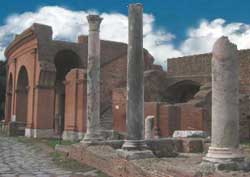Ostia Antica
 Why
Ostia Antica
is special
Why
Ostia Antica
is specialIt is the best preserved ancient Roman town. It has superlative mosaics and balconied multi-story buildings.
Top 5 attractions of Ostia Antica
Don't miss seeing these
My top-five list:
- Baths of Neptune
Splendid mosaic.
- Piazza of the Corporations
Artistic mosaics visually identify the specialties of dozens of companies (for the multitude who could not read). - Amphitheatre
Still being used today. - Forum
Remains of major temples. - Fireman's barracks
Ruins of a large fire-unit complex.
What functions did the town serve?
Ostia Antica served as both a military camp (to prevent invaders from sailing up the Tiber River to reach Rome) and the major commercial port for imports from distant lands destined for Rome.
How Pompeii and Ostia Antica differ
Quick comparison
True, Pompeii is a more exciting tourist draw than Ostia Antica because it was dramatically buried under the ashes of a Vesuvius eruption. However, Ostia Antica has its pluses. It is better preserved and gives the visitor a better idea of what a typical ancient Roman town was like.
More Ostia Antica tips and insights
Ostia Antica's history in brief
The city began to flourish in the 3rd century BC and reached its heyday about 500 years later when the population swelled to 100,000. But Mother Nature intervened. Accumulated silt moved the shoreline of the Tiber River estuary over 2 kilometers (1 mile) west into the sea. This hindered easy water passage to the town and eventually Ostia Antica became a ghost town.
What does the name mean in Latin?
Antica translates "ancient". Ostia means "mouth" in Latin, referring to the mouth of the Tiber River.
Nearest major city
Ostia Antica is an easy daytrip from Rome. It's 25 kilometers (15 miles) away and can be reached by car or train. There is even a boat excursion via the Tiber River.
Location in Italy



